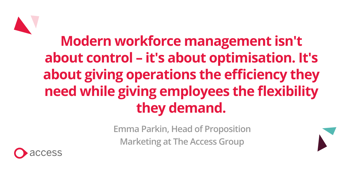 PeopleXD
PeopleXD
How Strategic Workforce Planning Powers Enterprise Growth
Strategic workforce planning has emerged as a critical lever for enterprise growth, transforming how organisations align their most valuable asset, their people, with long-term business objectives.
This comprehensive guide explores the common workforce planning challenges facing enterprises with 500+ employees, practical solutions to overcome them, and how modern workforce planning technology can power sustainable growth. We'll examine why basic scheduling tools fall short of enterprise needs and how strategic workforce planning frameworks provide a competitive advantage.
In this article we will explore the following areas:
- What is strategic workforce planning and why does it matter?
- What are the common challenges in workforce planning?
- What does a strategic workforce planning framework look like?
- How does the framework power enterprise growth?
- Beyond employee scheduling: the role of technology
- Future proofing with strategic workforce planning software

What is strategic workforce planning and why does it matter?
Strategic workforce planning represents a future-focused approach that aligns workforce capabilities with long-term business goals. Traditional employee scheduling focuses on filling immediate shifts and managing day-to-day operations. At its core, strategic workforce planning encompasses four principles:
- Forecasting: Predicting future workforce requirements based on data
- Gap Analysis: Identifying the difference between current workforce capabilities and future needs
- Scenario Planning: Prepare for different challenges
- Strategic Alignment: Support broader business objectives
Solutions like Access Workforce Management Software and our all-in-one HR software provide the analytical foundation and operational flexibility needed to transform workforce planning from an administrative function into a strategic capability that drives enterprise growth.
What are the common challenges in workforce planning?
Many large enterprises struggle with fundamental challenges that limit their ability to align talent with business objectives. Understanding these obstacles is the first step toward developing effective solutions.
Fragmented Data and Poor Visibility
Many organisations operate with disparate systems like payroll, scheduling, performance management, and learning and development. This fragmentation can create several problems:
- Incomplete workforce picture
- Reactive decision-making
- Inefficient resource allocation
Short-term Staffing Fixes Over Strategic Planning
Many enterprises fall into the trap of addressing immediate staffing needs without considering long-term implications, which can manifest in different ways:
- Emergency hiring
- Over-reliance on temporary staff
- Skills gaps persistence
Short-term staffing does have its place, particularly for seasonal workers. With strong engagement strategies, short-term hiring can translate to longer term retention. You can read more about hiring seasonal workers and the changes to the visa in our ‘Guide to hiring seasonal workers’.
Lack of Strategic Alignment Between HR and Business Operations
Perhaps the most significant challenge is the disconnect between workforce planning activities and broader business strategy. This misalignment typically occurs when:
- HR operates in isolation
- Limited cross-functional collaboration
- Absence of predictive analytics
Technology Limitations and Integration Challenges
Many enterprises rely on outdated systems that weren't designed for strategic workforce planning. Common technology-related challenges include:
- Legacy system constraints
- Poor integration capabilities
- Limited real-time reportin
Recognising when it's time to upgrade your HR technology stack is crucial for overcoming these challenges. To support this transition, we’ve developed two practical resources that explore how modern HR systems can drive efficiency, improve employee experience, and support long-term workforce planning.
You can download our guide, Moving Up the HR Tech Stack, to learn how to assess your current setup and identify the right time to invest in new solutions.
Or, if you prefer a more interactive format, watch our webinar, How to Upgrade Your HR Tech, where experts walk through the key steps to building a business case and implementing change with confidence.
Expert Insight
What are the common challenges in workforce planning?
Emma Parkin, Head of Propositions at The Access Group, shares insights into the current state of workforce management in the UK, highlighting key trends and challenges.
What does a strategic workforce planning framework look like?
A comprehensive strategic workforce planning framework provides enterprises with a structured approach to forecasting, planning, and optimising workforce capabilities.
The key components of an effective framework
Strategic workforce planning begins with a thorough analysis of your existing workforce. This comprehensive assessment encompasses multiple dimensions:
- Workforce composition analysis
- Capacity utilisation review
- Cost analysis
Our HR solution excels in this area by automatically aggregating data from multiple HR systems, providing real-time dashboards that visualise workforce composition, and enabling detailed drill-down analysis by department, location, skill set, or any other relevant dimension.
Effective workforce forecasting goes beyond headcount estimates. It aligns with business strategy, models demand using historical and projected data and anticipates how roles and skills will evolve due to technological and market changes.
Once future needs are clear, the framework identifies both quantitative gaps (like headcount shortages) and qualitative gaps (such as skill mismatches). Skills gaps and mismatches continue to be a problem in the UK and you can learn more about the data behind it in our ‘Skills shortage in the UK’ report. It also prioritises risks based on their potential impact on business objectives.
To close these gaps, organisations can develop targeted action plans. These include recruitment strategies, internal development programmes, succession planning, and contingency measures to adapt to changing business conditions.

How does the framework power enterprise growth?
Strategic workforce planning plays a vital role in helping organisations stay agile, innovative, and operationally efficient. With a clear view of current capabilities and future needs, businesses can move faster, scale more smoothly, and adapt confidently to changing market conditions. This kind of planning also supports innovation by ensuring the right mix of skills and fostering collaboration across teams, while operational excellence is achieved through smarter resource allocation and cost control.
Technology is a key enabler in this process. Platforms like Access PeopleXD Evo provide the analytics and visibility needed to link workforce decisions directly to business outcomes.
"Modern workforce management isn't about control – it's about optimisation. It's about giving operations the efficiency they need while giving employees the flexibility they demand."
Emma Parkin, Head of Proposition Marketing at The Access Group
Customer Success Story: Virgin Money
A great example of this in action is Virgin Money. During a major digital transformation, the company used strategic workforce planning to reduce time-to-competency for new digital roles by 40% and boost employee engagement by 25%. To learn more about their implementation of our software, read the whole Virgin Money Success Story.
Beyond employee scheduling: the role of technology
The evolution from basic employee scheduling to strategic workforce planning enable strategic decision-making that directly impacts business outcomes.
Why are rota tools alone not enough for an enterprise workforce?
Traditional rota and scheduling systems are useful for managing day-to-day workforce operations, but they fall short when it comes to strategic planning. These tools typically lack forecasting capabilities, don’t integrate well with broader business systems, and are designed for reactive management. All of this makes it difficult for HR leaders to anticipate future needs or align workforce decisions with business goals.
Modern workforce planning platforms like Access PeopleXD Evo offer a more comprehensive solution. It can provide predictive analytics, scenario modelling, and real-time workforce intelligence, enabling organisations to plan proactively, optimise resource allocation, and respond quickly to changing business conditions. These platforms also support better employee engagement through features like intelligent scheduling, absence forecasting, and self-service tools.
"Traditional workforce management creates a vicious cycle: poor visibility leads to reactive decisions, which create inefficiencies, which frustrate employees, which increases absence and turnover, which makes planning even harder."
Emma Parkin, Head of Proposition Marketing at The Access Group
For enterprise organisations, the choice between basic scheduling tools and comprehensive workforce planning platforms represents a fundamental decision about strategic capability. While traditional tools may meet immediate operational needs, they can't provide the strategic foundation required for sustainable competitive advantage in today's dynamic business environment.
Future proofing with strategic workforce planning software
The convergence of demographic shifts, rapid technological change, and rising employee expectations demands a more sophisticated, data-driven approach to workforce strategy.
Strategic workforce planning platforms like Access PeopleXD Evo enable organisations to build resilience and agility through planning, skills forecasting, and flexible workforce models. These capabilities allow businesses to respond quickly to change, develop future-ready talent, and align workforce decisions with broader business goals.
Integrated analytics are central to this transformation. Rather than simply reporting on past performance, modern platforms provide predictive insights, map emerging skill needs, and support succession planning.
For enterprise organisations, the question is now about how quickly and effectively workforce planning software can be implemented. Strategic workforce planning requires a technology platform that grows with your ambitions. Our detailed comparison of the best HCM software in the UK evaluates platforms on their workforce planning capabilities.
If you're looking to streamline scheduling, optimise resource allocation, and improve employee engagement, explore how Access Workforce Management Software can support your operational goals.
To understand how an integrated HR platform can elevate your workforce strategy, take a closer look at Access PeopleXD Evo and its capabilities across planning, analytics, and employee experience.
Ready to see how it works in practice?
Book a demo of Access PeopleXD Evo and discover how it can help transform your approach to strategic workforce planning.

Workforce Management brochure
Find out how our HR software can help you achieve your business goals.

Schedule your demo
One of our HR software experts will be in touch to build a demo with the features you need to see.

Watch 4-min demo
Explore the features and benefits PeopleXD Evo offers in our 4 minute video.

Unlock Expert HR Insights
Stay ahead in the ever-changing world of HR with our on-demand webinar hub. Explore a wide range of sessions led by industry experts.

 AU & NZ
AU & NZ
 SG
SG
 MY
MY
 US
US
 IE
IE

